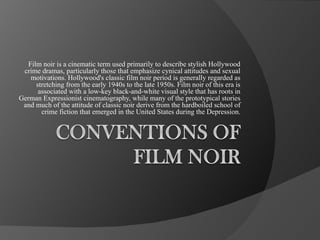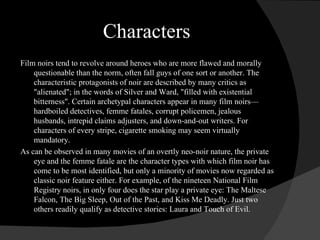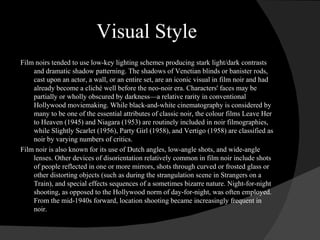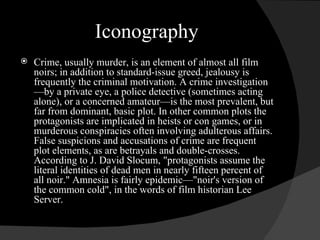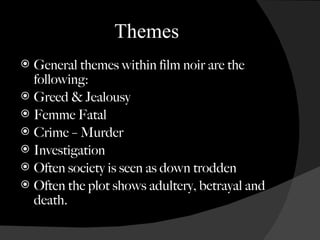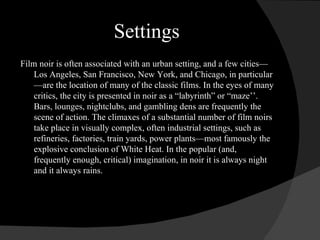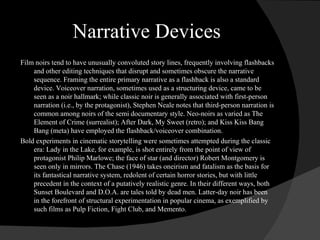Film Noir Presentation
- 1. Film noir is a cinematic term used primarily to describe stylish Hollywood crime dramas, particularly those that emphasize cynical attitudes and sexual motivations. Hollywood's classic film noir period is generally regarded as stretching from the early 1940s to the late 1950s. Film noir of this era is associated with a low-key black-and-white visual style that has roots in German Expressionist cinematography, while many of the prototypical stories and much of the attitude of classic noir derive from the hardboiled school of crime fiction that emerged in the United States during the Depression.
- 2. Characters Film noirs tend to revolve around heroes who are more flawed and morally questionable than the norm, often fall guys of one sort or another. The characteristic protagonists of noir are described by many critics as "alienated"; in the words of Silver and Ward, "filled with existential bitterness". Certain archetypal characters appear in many film noirs—hardboiled detectives, femme fatales, corrupt policemen, jealous husbands, intrepid claims adjusters, and down-and-out writers. For characters of every stripe, cigarette smoking may seem virtually mandatory. As can be observed in many movies of an overtly neo-noir nature, the private eye and the femme fatale are the character types with which film noir has come to be most identified, but only a minority of movies now regarded as classic noir feature either. For example, of the nineteen National Film Registry noirs, in only four does the star play a private eye: The Maltese Falcon, The Big Sleep, Out of the Past, and Kiss Me Deadly. Just two others readily qualify as detective stories: Laura and Touch of Evil.
- 3. Visual Style Film noirs tended to use low-key lighting schemes producing stark light/dark contrasts and dramatic shadow patterning. The shadows of Venetian blinds or banister rods, cast upon an actor, a wall, or an entire set, are an iconic visual in film noir and had already become a cliché well before the neo-noir era. Characters' faces may be partially or wholly obscured by darkness—a relative rarity in conventional Hollywood moviemaking. While black-and-white cinematography is considered by many to be one of the essential attributes of classic noir, the colour films Leave Her to Heaven (1945) and Niagara (1953) are routinely included in noir filmographies, while Slightly Scarlet (1956), Party Girl (1958), and Vertigo (1958) are classified as noir by varying numbers of critics. Film noir is also known for its use of Dutch angles, low-angle shots, and wide-angle lenses. Other devices of disorientation relatively common in film noir include shots of people reflected in one or more mirrors, shots through curved or frosted glass or other distorting objects (such as during the strangulation scene in Strangers on a Train), and special effects sequences of a sometimes bizarre nature. Night-for-night shooting, as opposed to the Hollywood norm of day-for-night, was often employed. From the mid-1940s forward, location shooting became increasingly frequent in noir.
- 4. Iconography Crime, usually murder, is an element of almost all film noirs; in addition to standard-issue greed, jealousy is frequently the criminal motivation. A crime investigation—by a private eye, a police detective (sometimes acting alone), or a concerned amateur—is the most prevalent, but far from dominant, basic plot. In other common plots the protagonists are implicated in heists or con games, or in murderous conspiracies often involving adulterous affairs. False suspicions and accusations of crime are frequent plot elements, as are betrayals and double-crosses. According to J. David Slocum, "protagonists assume the literal identities of dead men in nearly fifteen percent of all noir." Amnesia is fairly epidemic—"noir's version of the common cold", in the words of film historian Lee Server.
- 5. Themes General themes within film noir are the following: Greed & Jealousy Femme Fatal Crime – Murder Investigation Often society is seen as down trodden Often the plot shows adultery, betrayal and death.
- 6. Settings Film noir is often associated with an urban setting, and a few cities—Los Angeles, San Francisco, New York, and Chicago, in particular—are the location of many of the classic films. In the eyes of many critics, the city is presented in noir as a “labyrinth” or “maze’’. Bars, lounges, nightclubs, and gambling dens are frequently the scene of action. The climaxes of a substantial number of film noirs take place in visually complex, often industrial settings, such as refineries, factories, train yards, power plants—most famously the explosive conclusion of White Heat. In the popular (and, frequently enough, critical) imagination, in noir it is always night and it always rains.
- 7. Narrative Devices Film noirs tend to have unusually convoluted story lines, frequently involving flashbacks and other editing techniques that disrupt and sometimes obscure the narrative sequence. Framing the entire primary narrative as a flashback is also a standard device. Voiceover narration, sometimes used as a structuring device, came to be seen as a noir hallmark; while classic noir is generally associated with first-person narration (i.e., by the protagonist), Stephen Neale notes that third-person narration is common among noirs of the semi documentary style. Neo-noirs as varied as The Element of Crime (surrealist); After Dark, My Sweet (retro); and Kiss Kiss Bang Bang (meta) have employed the flashback/voiceover combination. Bold experiments in cinematic storytelling were sometimes attempted during the classic era: Lady in the Lake, for example, is shot entirely from the point of view of protagonist Philip Marlowe; the face of star (and director) Robert Montgomery is seen only in mirrors. The Chase (1946) takes oneirism and fatalism as the basis for its fantastical narrative system, redolent of certain horror stories, but with little precedent in the context of a putatively realistic genre. In their different ways, both Sunset Boulevard and D.O.A. are tales told by dead men. Latter-day noir has been in the forefront of structural experimentation in popular cinema, as exemplified by such films as Pulp Fiction, Fight Club, and Memento.
